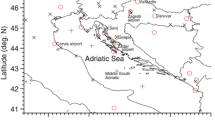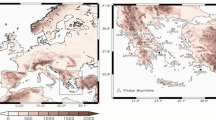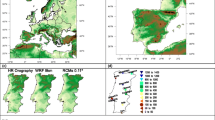Abstract
We present the first evaluation of the wind field from the ensemble of kilometer-scale simulations from the CORDEX-Flagship Pilot Study on convection, with focus on the Adriatic region. Kilometer-scale climate models, also known as convection-permitting models (CPMs), produce a good representation of small-scale topographic features and consequently a more detailed depiction of dynamical and thermal circulations. These enable a reliable view of climate characteristics of the wind field, especially in coastal regions and over complex terrain, such as the Adriatic region. We investigate the (potential) added value introduced by CPMs compared to classical “cumulus-parametrized” regional climate models (RCMs), reanalysis and station observations. For this purpose, wind components at 10 m level are used at 3-hourly frequency. All simulations cover a 10-year period, extending from 2000 to 2009. In terms of the standard statistical parameters such as correlation coefficient and temporal standard deviation, CPMs are very dependent on their parent RCM performance. However, the orographic forcing emphasizes the potential added value and CPMs contain some fine spatial scale variability (i.e., stronger extremes by 25% and more accurate wind direction) that is absent in coarser RCMs and reanalysis. The potential added value is higher in the cold season compared to the warm season due to the proportion of severe wind events. CPMs reproduce well the typical wind regimes along the Adriatic coast, namely Bora and Sirocco. The benefit of using CPMs is especially pronounced in simulating Bora maximum wind speeds in northern Adriatic and Sirocco frequencies in southern Adriatic. Based on our overall analysis, we conclude that CPMs provide added value compared to coarser models, especially in the complex coastal terrain.









Similar content being viewed by others
Data availability
The datasets analyzed during the current study are available via the data exchange infrastructure and services provided by the Jülich Supercomputing Centre, Germany, as part of the Helmholtz Data Federation initiative.
References
Adinolfi M, Raffa M, Reder A, Mercogliano P (2021) Evaluation and expected changes of summer precipitation at convection permitting scale with COSMO-CLM over alpine space. Atmosphere 12(1):54. https://doi.org/10.3390/atmos12010054
Bajić A (1989) Severe bora on the northern Adriatic part I: statistical analysis. Croatian Meteorol J 24(24):1–9
Baldauf M, Seifert A, Förstner J, Majewski D, Raschendorfer M, Reinhardt T (2011) Operational convection-scale numerical weather prediction with the COSMO model: description and sensitivities. Mon Weather Rev 139:3887–3905. https://doi.org/10.1175/MWR-D-10-05013.1
Ban N, Schmidli J, Schär C (2014) Evaluation of the convection-resolving regional climate modeling approach in decade-long simulations. J Geophys Res Atmos 119:7889–7907. https://doi.org/10.1002/2014JD021478
Ban N, Schmidli J, Schär C (2015) Heavy precipitation in a changing climate: does short-term summer precipitation increase faster? Geophys Res Lett 42:1165–1172. https://doi.org/10.1002/2014GL062588
Ban N, Caillaud C, Coppola E et al (2021) The first multi-model ensemble of regional climate simulations at kilometer-scale resolution, part I: evaluation of precipitation. Clim Dyn 57:275–302. https://doi.org/10.1007/s00382-021-05708-w
Belušić A, Prtenjak MT, Güttler I, Ban N, Leutwyler D, Schär C (2018) Near-surface wind variability over the broader Adriatic region: insights from an ensemble of regional climate models. Clim Dyn 50:4455–4480. https://doi.org/10.1007/s00382-017-3885-5
Belušić D, de Vries H, Dobler A et al (2020) HCLIM38: a flexible regional climate model applicable for different climate zones from coarse to convection permitting scales. Geosci Model Dev 13:1311–1333. https://doi.org/10.5194/gmd-13-1311-2020
Belušić Vozila A, Güttler I, Ahrens B, Obermann-Hellhund A, Telišman Prtenjak M (2019) Wind over the Adriatic region in CORDEX climate change scenarios. J Geophys Res Atmos 124:110–130. https://doi.org/10.1029/2018JD028552
Belušić Vozila A, Telišman Prtenjak M, Güttler I (2021) A weather-type classification and its application to near-surface wind climate change projections over the Adriatic Region. Atmosphere 12(8):948. https://doi.org/10.3390/atmos1208094
Bencetić Klaić Z, Prodanov AD, Belušić D (2009) Wind measurements in Senj – underestimation of true bora flows. Geofizika 26(2):245–252
Bonaldo D, Bucchignani E, Ricchi A, Carniel S (2017) Wind storminess in the Adriatic Sea in a climate change scenario. Acta Adriat 58(2):195–208
Ciarlò JM, Coppola E, Fantini A et al (2021) A new spatially distributed added value index for regional climate models: the EURO-CORDEX and the CORDEX-CORE highest resolution ensembles. Clim Dyn 57:1403–1424. https://doi.org/10.1007/s00382-020-05400-5
Colin J, Déqué M, Radu R, Somot S (2010) Sensitivity study of heavy precipitations in Limited Area Model climate simulation: influence of the size of the domain and the use of the spectral nudging technique. Tellus A 62:591–604. https://doi.org/10.1111/j.1600-0870.2010.00467.x
Coppola E, Sobolowski S, Pichelli E et al (2020) A first-of-its-kind multi-model convection permitting ensemble for investigating convective phenomena over Europe and the Mediterranean. Clim Dyn 55:3–34. https://doi.org/10.1007/s00382-018-4521-8
Coppola E, Stocchi P, Pichelli E, Torres Alavez JA, Glazer R, Giuliani G, Di Sante F, Nogherotto R, Giorgi F (2021) Non-Hydrostatic RegCM4 (RegCM4-NH): model description and case studies over multiple domains. Geosci Model Dev 14:7705–7723. https://doi.org/10.5194/gmd-14-7705-2021
Dee DP, Uppala SM, Simmons AJ et al (2011) The ERA-Interim reanalysis: configuration and performance of the data assimilation system. Q J R Meteorol Soc 137:553–597. https://doi.org/10.1002/qj.828
Di Luca A, de Elía R, Laprise R (2012) Potential for added value in precipitation simulated by high-resolution nested Regional Climate Models and observations. Clim Dyn 38:1229–1247. https://doi.org/10.1007/s00382-011-1068-3
Di Luca A, De Elía R, Laprise R (2015) Challenges in the Queste for added value of regional climate dynamical downscaling. Curr Clim Change Rep 1:10–21. https://doi.org/10.1007/s40641-015-0003-9
Fumière Q, Déqué M, Nuissier O, Somot S, Alias A, Caillaud C, Laurantin O, Seity Y (2020) Extreme rainfall in Mediterranean France during the fall: added value of the CNRM-AROME convection-permitting regional climate model. Clim Dyn 55:77–91. https://doi.org/10.1007/s00382-019-04898-8
Giorgi F, Coppola E, Solmon F et al (2012) RegCM4: model description and preliminary tests over multiple CORDEX domains. Clim Res 52:7–29. https://doi.org/10.3354/cr01018
Grisogono B, Belušić D (2009) A review of recent advances in understanding the meso- and microscale properties of the severe Bora wind. Tellus A 61:1–16. https://doi.org/10.1111/j.1600-0870.2008.00369.x
Grubišić V (2004) Bora-driven potential vorticity banners over the Adriatic. Q J R Meteorol Soc 130:2571–2603. https://doi.org/10.1256/qj.03.71
Gutowski WJ Jr, Ullrich PA, Hall A et al (2020) The ongoing need for high-resolution regional climate models: process understanding and stakeholder information. B Am Meteorol Soc 101(5):E664–E683. https://doi.org/10.1175/BAMS-D-19-0113.1
Herrmann M, Somot S, Calmanti S, Dubois C, Sevault F (2011) Representation of spatial and temporal variability of daily wind speed and of intense wind events over the Mediterranean Sea using dynamical downscaling: impact of the regional climate model configuration. Nat Hazards Earth Sys Sci 11:1983–2001. https://doi.org/10.5194/nhess-11-1983-2011
Hersbach H, Bell B, Berrisford P et al (2020) The ERA5 Global Reanalysis. Q J R Meteorol Soc 146:1999–2049. https://doi.org/10.1002/qj.3803
Horvath K, Lin YL, Ivančan-Picek B (2008) Classification of cyclone tracks over the Apennines and the Adriatic Sea. Mon Wea Rev 136:2210–2227. https://doi.org/10.1175/2007MWR2231.1
Horvath K, Bajić A, Ivatek-Šahdan S (2011) Dynamical Downscaling of wind speed in complex terrain prone to bora-type flows. J Appl Meteorol Clim 50:1676–1691. https://doi.org/10.1175/2011JAMC2638.1
Jacob D, Teichmann C, Sobolowski S et al (2020) Regional climate downscaling over Europe: perspectives from the EURO-CORDEX community. Reg Environ Change 20:51. https://doi.org/10.1007/s10113-020-01606-9
Kendon EJ, Prein AF, Senior CA, Stirling A (2021) Challenges and outlook for convection-permitting climate modelling. Phil Trans R Soc 379:20190547. https://doi.org/10.1098/rsta.2019.0547
Kuzmić M, Li XM, Grisogono B, Tomažić I, Lehner S (2013) Terra SAR-X observations of the northeastern Adriatic bora: early results. Acta Adriat 54:13–26
Leutwyler D, Lüthi D, Ban N, Fuhrer O, Schär C (2017) Evaluation of the convection-resolving climate modeling approach on continental scales. J Geophys Res Atmos 122:5237–5258. https://doi.org/10.1002/2016JD026013
Međugorac I, Pasarić M, Orlić M (2015) Severe flooding along the eastern Adriatic coast: the case of 1 December 2008. Ocean Dyn 65(6):817–830. https://doi.org/10.1007/s10236-015-0835-9
Menendez M, García-Díez M, Fita L, Fernández J, Méndez FJ, Gutiérrez JM (2014) High-resolution sea wind hindcasts over the Mediterranean area. Clim Dyn 42:1857–1872. https://doi.org/10.1007/s00382-013-1912-8
Meredith EP, Ulbrich U, Rust HW (2020) Subhourly rainfall in a convection-permitting model. Environ Res Lett 15:034031. https://doi.org/10.1088/1748-9326/ab6787
Obermann A, Bastin S, Belamari S, Conte D, Gaertner MA, Li L, Ahrens B (2016) Mistral and Tramontane wind speed and wind direction patterns in regional climate simulation. Clim Dyn 47:1–18. https://doi.org/10.1007/s00382-016-3053-3
Pasarić Z, Belušić D, Klaić ZB (2007) Orographic influences on the Adriatic sirocco wind. Ann Geophys 25:1263–1267. https://doi.org/10.5194/angeo-25-1263-2007
Penzar B, Penzar B, Orlić M (2001) Weather and climate of the Croatian Adriatic (in Croatian). Nakladna kuća “Dr. Feletar”. Zagreb: Hrvatski hidrografski institut
Perkins SE, Pitman AJ, Holbrook NJ, McAneney J (2007) Evaluation of the AR4 climate models’ simulated daily maximum temperature, minimum temperature, and precipitation over Australia using probability density functions. J Clim 20:4356–4376. https://doi.org/10.1175/JCLI4253.1
Pichelli E, Coppola E, Sobolowski S et al (2021) The first multi-model ensemble of regional climate simulations at kilometer-scale resolution part 2: historical and future simulations of precipitation. Clim Dyn 56:3581–3602. https://doi.org/10.1007/s00382-021-05657-4
Poje D (1992) Wind persistence in Croatia. Int J Climatol 12:569–586. https://doi.org/10.1002/joc.3370120604
Powers JG, Klemp JB, Skamarock WC et al (2017) The weather research and forecasting model: overview, system efforts, and future directions. B Am Meteorol Soc 98(8):1717–1737. https://doi.org/10.1175/BAMS-D-15-00308.1
Prtenjak MT, Horvat I, Tomažić I, Kvakić M, Viher M, Grisogono B (2015) Impact of mesoscale meteorological processes on anomalous radar propagation conditions over the northern Adriatic area. J Geophys Res Atmos 120:8759–8782. https://doi.org/10.1002/2014JD022626
Rockel B, Will A, Hense A (2008) The regional climate model COSMO-CLM (CCLM). Meteorol Z 17:347–348. https://doi.org/10.1127/0941-2948/2008/0309
Ruti PM, Somot S, Giorgi F et al (2016) Med-CORDEX initiative for Mediterranean climate studies. B Am Meteorol Soc 97:1187–1208. https://doi.org/10.1175/BAMS-D-14-00176.1
Schär C, Fuhrer O, Arteaga A, Ban N, Charpilloz C, Di Girolamo S, Hentgen L, Hoefler T, Lapillonne X, Leutwyler D, Osterried K, Panosetti D, Rüdisühli S, Schlemmer L, Schulthess T, Sprenger M, Ubbiali S, Wernli H (2020) Kilometer-scale climate models: prospects and challenges. B Am Meteorol Soc 101:E567–E587. https://doi.org/10.1175/BAMS-D-18-0167.1
Skamarock WC, Klemp JB, Dudhia J, Gill DO, Liu Z, Berner J, Wang W, Powers JG, Duda MG, Barker DM, Huang XY (2019) A description of the advanced research WRF version 4. NCAR Tech. Note NCAR/TN-556+STR, p 145
Smith A, Lott N, Vose R (2011) The integrated surface database: recent developments and partnerships. B Am Meteorol Soc 92:704–708. https://doi.org/10.1175/2011BAMS3015.1
Somot S, Ruti PM, The MedCORDEX Team (2011) The Med-CORDEX initiative: towards fully coupled Regional Climate System Models to study the Mediterranean climate variability, change and impact. https://www.medcordex.eu/somot_MedCORDEX_WCRP2011_Denver_oct2011.pdf. Accessed 10 Jan 2022
Stiperski I, Ivančan-Picek B, Grubišić V, Bajić A (2012) Complex Bora flow in the lee of Southern Velebit. Q J R Meteorol Soc 138:1490–1506. https://doi.org/10.1002/qj.1901
Torma C, Giorgi F, Coppola E (2015) Added value of regional climate modeling over areas characterized by complex terrain precipitation over the Alps. J Geophys Res Atmos 120:3957–3972. https://doi.org/10.1002/2014JD022781
Tyrlis E, Lelieveld J (2013) Climatology and Dynamics of the Summer Etesian Winds over the Eastern Mediterranean. JAS 70:3374–3396. https://doi.org/10.1175/JAS-D-13-035.1
Ulbrich U, Lionello P, Belušić D et al (2012) Climate of the Mediterranean: synoptic patterns, temperature, precipitation, winds, and their extremes. In: Lionello P (ed) The Climate of the Mediterranean Region - From the Past to the Future. Elsevier, Amsterdam, pp 301–346
Van Meijgaard E, Van Ulft LH, Van De Berg WJ, Bosvelt FC, Van Den Hurk BJJM, Lenderink G, Siebesma AP (2008) The KNMI regional atmospheric model RACMO version 2.1, technical report 302. Technical report, De Bilt KNMI, The Netherlands. http://bibliotheek.knmi.nl/knmipubTR/TR302.pdf. Accessed 22 Feb 2022
Večenaj Ž, Belušić D, Grubišić V et al (2012) Along-Coast features of bora-related turbulence. Boundary-Layer Meteorol 143:527–545. https://doi.org/10.1007/s10546-012-9697-6
Zecchetto S, Cappa C (2001) The spatial structure of the Mediterranean Sea winds revealed by ERS-1 scatterometer. Int J Remote Sens 22:45–70. https://doi.org/10.1080/014311601750038848
Acknowledgements
All authors gratefully acknowledge the WCRP-CORDEX-FPS on Convective phenomena at high resolution over Europe and the Mediterranean (FPSCONVALP- 3) and the research data exchange infrastructure and services provided by the Jülich Supercomputing Centre, Germany, as part of the Helmholtz Data Federation initiative. The ETH, IPSL, ICTP, SMHI, CMCC, KNMI acknowledge funding from the HORIZON 2020 EUCP (European Climate Prediction System) project (https:// www. eucp- project.eu, grant agreement No. 776613). IPSL’s work was granted access to the HPC resources of TGCC under the allocations 2019-A0030106877 and 2020-A0030106877 made by GENCI. DB acknowledges funding from the FORMAS project EDUCAS (grant no. 2019-00829). MED acknowledges the Partnership for advanced computing in Europe (PRACE) for awarding access to Piz Daint at ETH Zürich at the Swiss National Supercomputing Centre (CSCS, Switzerland). MED also acknowledges the Federal Office for Meteorology and Climatology (MeteoSwiss), CSCS, the Center for Climate Systems Modeling (C2SM) and ETH Zürich for their contributions to the development and maintenance of the GPU-accelerated version of COSMO. ØH has received support from the project GREAT, funded by the Research Council of Norway (grant no. 275589), and acknowledge computing resources from Notur (NN9188K). SK acknowledges the support of the Greek Research and Technology Network (GRNET) High Performance Computing (HPC) infrastructure for providing the computational resources of AUTH-simulations (under project IDs pr003005 and pr009020) and the AUTH Scientific Computing Center for technical support. JM acknowledges the support from the Spanish Agencia Estatal de Investigación through the Unidad de Excelencia María de Maeztu with reference MDM-2017-0765, the projects CORDyS (PID2020-116595RB-I00) and ATLAS (PID2019-111481RB-I00), both funded by MCIN/AEI/10.13039/501100011033. EP acknowledges the Consorzio Inter-universitario per il Calcolo Automatico dell’Italia Nord Orientale (CINECA) super-computing center (Bologna, Italy) for computing resources dedicated to ICTP simulations. HT is thankful for the computational resources granted by the John von Neumann Institute for Computing (NIC) and provided on the supercomputer JURECA at the Jülich Supercomputing Centre (JSC) through the grant JJSC39 and for the computational resources at the Vienna Scientific Cluster (VSC) through the grants 70992 and 71193, the long-term storage provided by the cooperation project GEOCLIM Data Infrastructure Austria, funded by the Austrian Education, Science and Research Ministry (BMBWF), as well as for the support received via the project “reclip:convex”, funded by the Austrian Climate Research Programme (ACRP) of the Klima- und Energiefonds (no. B769999).
Funding
The ETH, IPSL, ICTP, SMHI, CMCC, KNMI was supported by the HORIZON 2020 EUCP (European Climate Prediction System) project (https:// www. eucp- project.eu, grant agreement No. 776613). DB was supported by the FORMAS project EDUCAS (grant no. 2019–00829). HT was supported by the John von Neumann Institute for Computing (NIC) through the grant JJSC39 and by Vienna Scientific Cluster (VSC) through the grants 70992 and 71193, the long-term storage provided by the cooperation project GEOCLIM Data Infrastructure Austria, funded by the Austrian Education, Science and Research Ministry (BMBWF). HT was supported via the project “reclip:convex”, funded by the Austrian Climate Research Programme (ACRP) of the Klima- und Energiefonds (no. B769999). JM was supported from the Spanish Agencia Estatal de Investigación through the Unidad de Excelencia María de Maeztu with reference MDM-2017–0765, the projects CORDyS (PID2020-116595RB-I00) and ATLAS (PID2019-111481RB-I00), both funded by MCIN/AEI/10.13039/501100011033. ØH has received support from the project GREAT, funded by the Research Council of Norway (grant no. 275589).
Author information
Authors and Affiliations
Contributions
ABV, DB, MTP and IG contributed to the study conception and design. Material preparation, data collection and analysis were performed by ABV. The authors DB and from SB to KWS performed the simulations. The first draft of the manuscript was written by ABV and all authors commented on previous versions of the manuscript. All authors read and approved the final manuscript.
Corresponding author
Ethics declarations
Conflict of interest
The authors have no relevant financial or non-financial interests to disclose.
Additional information
Publisher's Note
Springer Nature remains neutral with regard to jurisdictional claims in published maps and institutional affiliations.
Rights and permissions
Springer Nature or its licensor (e.g. a society or other partner) holds exclusive rights to this article under a publishing agreement with the author(s) or other rightsholder(s); author self-archiving of the accepted manuscript version of this article is solely governed by the terms of such publishing agreement and applicable law.
About this article
Cite this article
Belušić Vozila, A., Belušić, D., Telišman Prtenjak, M. et al. Evaluation of the near-surface wind field over the Adriatic region: local wind characteristics in the convection-permitting model ensemble. Clim Dyn (2023). https://doi.org/10.1007/s00382-023-06703-z
Received:
Accepted:
Published:
DOI: https://doi.org/10.1007/s00382-023-06703-z




